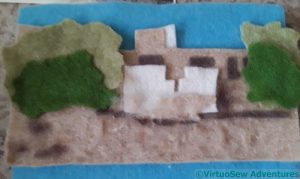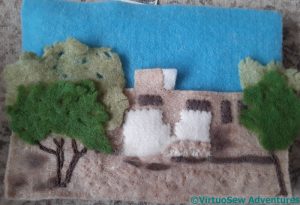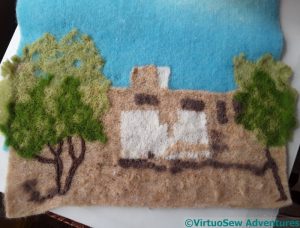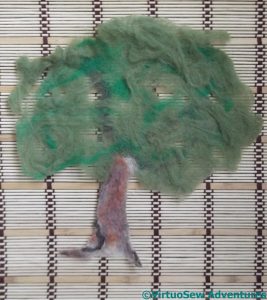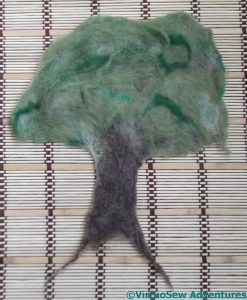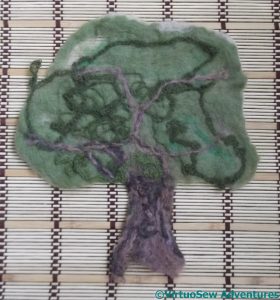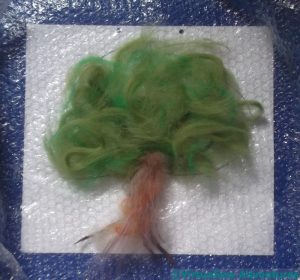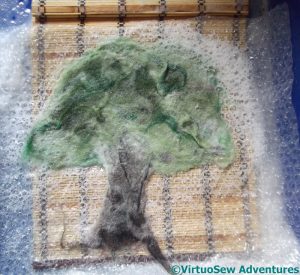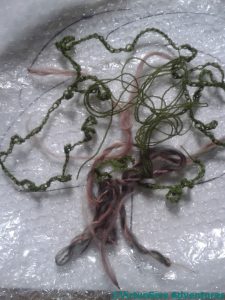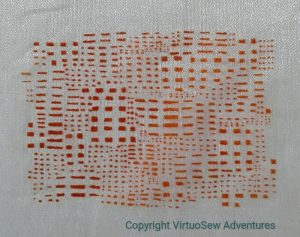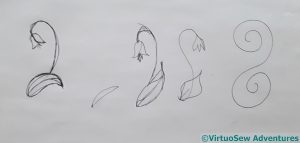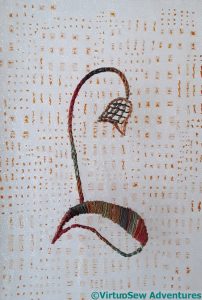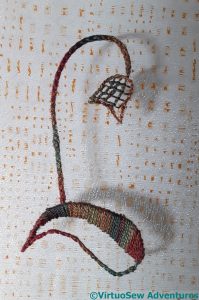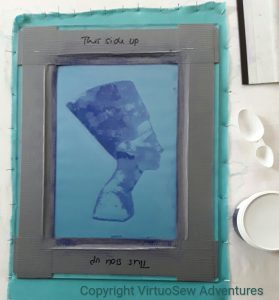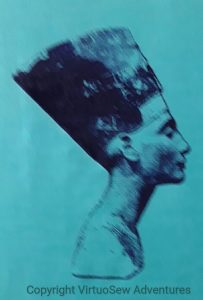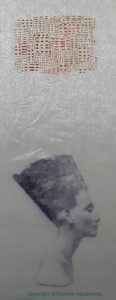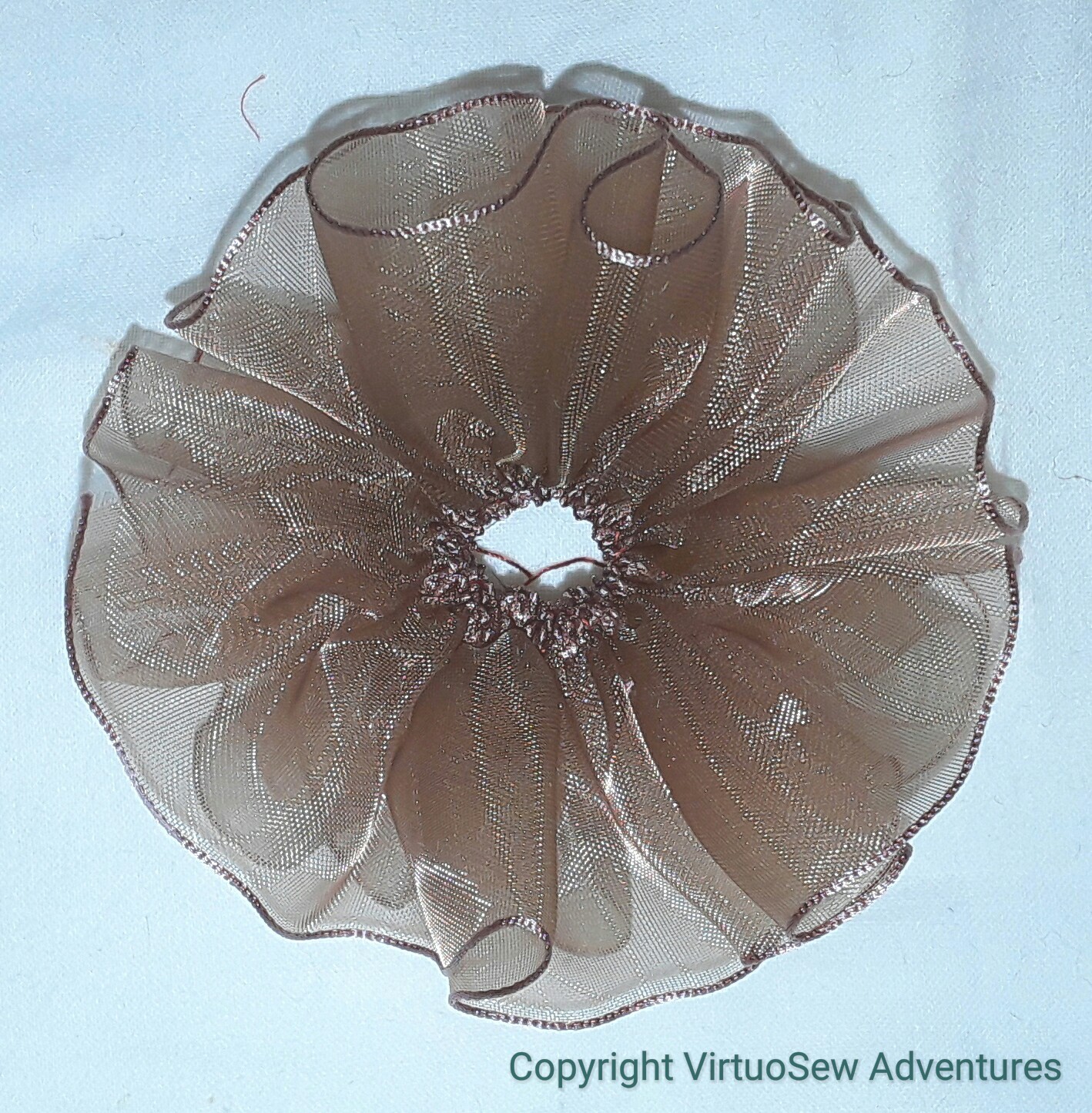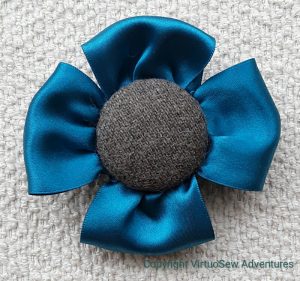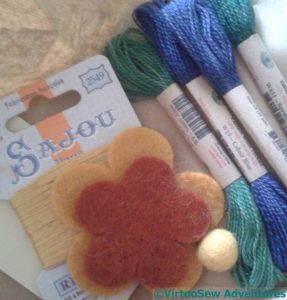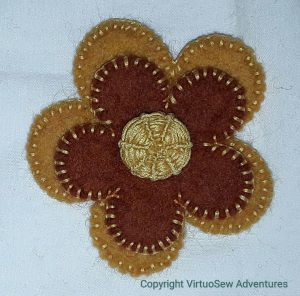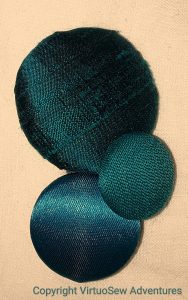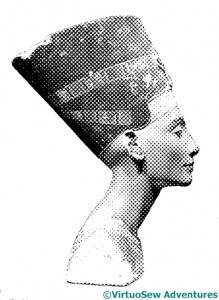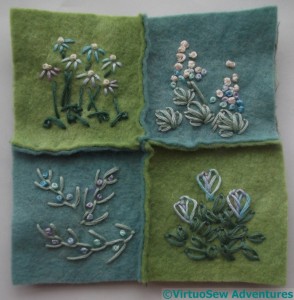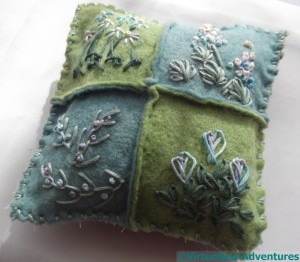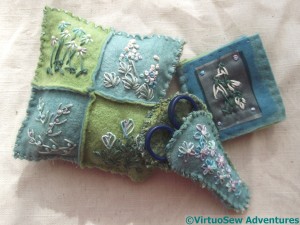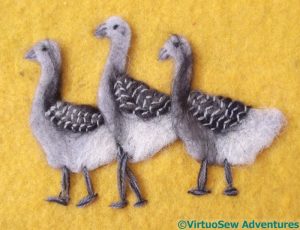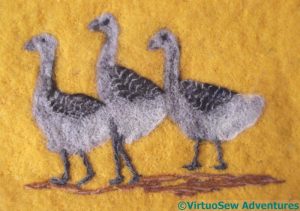Tag: experiments
Another Attempt at the Dig House
I’m continuing to experiment with my embellisher, trying to learn new tricks.
I’ve found a photo of the Dig House from a different view to the previous one I tried, and cut out some pieces of felt to represent the trees and the various pieces of building. It’s not going to be a very accurate representation, because, firstly, my cutting wasn’t as accurate as it could have been, and second, I’ve found that needlefelting doesn’t always go to plan.
That said, a bit of stitchery helps to keep the pieces at least approximately in place.
I felt the felt of the trees looked a bit too solid, and snipped holes in it, snipped the edges, and then tugged and tweaked at it to open up the fabric.
Then I started to use my embellisher. And oh joy, a needle broke! I changed the needle plate and slowed down a bit after that. It turns out that three layers of even this fairly light felt are a bit much for the machine.
However, after much slow and careful embellishing, I have this.
The trees look much better now, with the edges and the holes satisfactorily destroyed and battered around the edges. The various layers of felt are melting into one another and flattening together.
This should at least provide me with an interesting basis for further stitched details!
Some early (very early!) experiments for the Vision Of Placidus – Part Two
Once everything had dried, I could sit back and look at my trees.
This is the first one I did. It used some multicoloured merino in the trunk, and two greens from the beginners felting kit I bought on eBay a while back. They’re not very nice greens, but all I’m doing is investigating the technique.
There are only two or three layers of wool in this one, which means there are gaps in the felt, and the junction of the trunk and the canopy is a bit flimsy. Gaps in the felt for the canopy are no problem at all – they would help to add depth to the finished piece. Since everything will be caught down (somehow – I don’t yet know how!), strong, dense felt isn’t really the aim here.
The second experiment had the addition of some short staple (that is, short fibre length), very crinkly wool. I was hoping it would result in greater shrinkage, which it has a little. It also produced a greater variety of shades in the canopy, lightening and interrupting that rather dull green. This may have promise, and the felt itself seems a little more stable and would be easier to stitch into.
Since the fibres are rubbed and soaped and rolled, and generally beaten up, it’s not surprising that the effects of trying to place the fibre colours to create a particular appearance is, to put it mildly, an inexact science. I wonder whether I could combine needle-felting with wet-felting to make the results more controllable?
In the final experiment, I added crocheted chains and some tangles of yarn as well. Some parts of the chain didn’t felt in quite as well as I might have hoped, but with more crocheted chain and a better understanding of how to felt it in more thoroughly, it might produce a very good effect.
My semi-spun yarn on the trunk has worked, though, and looks even better in real life, although, again, what it needs is the courage of my convictions and rather more of the same.
So, not a completely unsuccessful experiment, and certainly a good basis for further experiments, perhaps with added stitching…
Some early (very early!) experiments for the Vision Of Placidus – Part One
I’ve been struggling with a sore and stiff shoulder for some months now. It’s made me reluctant to go back to Eve In The Garden of Eden because at this stage she demands perseverance in a single, small stitch for the gold groundwork. The Head of Nefertiti has involved more variety, and earlier signs of progress, while the canvaswork is perfect for evenings.
However, my shoulder is beginning to ease and I’m feeling more willing to experiment. So I had a very entertaining morning last week (it was on Instagram and Twitter) having a go at something I saw on someone’s blog a few months ago and thought might have possibilities for the underlayer of my planned Vision of Placidus panel. If what you see looks familiar, please let me know and I will gladly edit the post to give credit!
Now, the Placidus panel is going to be about five foot by four foot, so even using some of the chunky threads I am happy to use (… and may even spin for the purpose!), it will take quite some effort to cover it. So I thought maybe I could wet felt some rough elements – trees, rocks, clouds, the stream, which could then be applied and tweaked, improved and generally titivated with stitchery.
In the absence of a real – waterproofed! – studio, therefore, I was to be found squatting on the kitchen floor, using a Lakeland Limited tray for cleaning oven shelves to contain the splashes and soap. I must have looked distinctly odd, but I’m accustomed to that!
In the case of the final experiment ( I did three), I rummaged for some fine crewel wool and made a crochet chain, with some very slapdash and freeform loops added in, and laid that down first, with a tangle of leftover yarn.
I also fished out my spindle and had a go at spinning and doubling some wool to create a different effect on the trunk. That didn’t work too well – the yarn kept unspinning itself. My shoulder isn’t up to a concerted attempt to crack spinning, so I made do with what I’d got, and backed it with various other wools to hold it together.
At this point – creaking slightly in the lower back – I decided to stop, rinse everything off, and let my trees dry before going any further. .
Shadow Play
I decided, as I stared at the printing of this blocky pattern onto gauze, that I wanted to use the transparency of the gauze as part of the finished effect.
I don’t have a destination in mind for this piece which will give me a theme, so I decided that, in order to highlight that one quality, I would use a single thread (as it happened, a variegated silk), and design a fragment that would allow me to experiment with the effect of stitch cover and openness.
I leafed through books about pattern, saw nothing that gave me the combination I wanted, and then evolved the fragmentary organic sketch on the far left to give me the balance of line and form I was looking for. Incidentally, this is quite possibly the swiftest and shortest progression of any sketched design I’ve ever come up with!
It’s astonishingly difficult to trace a design onto a fabric which is essentially invisible, and still harder, I might add, to follow the lines when you have finally put them there!
I used Hungarian Braided Chain Stitch for the stem, satin stitch for the solid side of the leaf, and Jacobean trellis for the flower-head. Clearly that gives me a solid coverage, and a firm line; I was hoping that the Jacobean trellis might offer a sort of half-shade.
A qualified success, I’d say. The printed pattern doesn’t create a shadow, and the Jacobean trellis shadow isn’t a sort of half-depth.
But, my goodness, the shadow of the stem and the leaf work exactly as I hoped! The gauze itself almost disappears, leaving the printed pattern floating above the surface, and the leaf and flower thrown forward by their shadows.
Experiments for The Head of Nefertiti
You may recall that the final “Dreams of Amarna” pair of panels is intended to include the heads of Akhenaten and Nefertiti, screenprinted onto gauze, and floating over the top as free-hanging veils.
I decided to have a small screen done of Nefertiti, in order to practice the technique and experiment with the different types of gauze.
The screen duly arrived, and I did about six prints, all of which were dreadful. I put the screen away in disgust and decided to try another time.
This print shows some of the problems. I pressed too hard, obscuring some of the detail and caking the fabric – in this case a linen, because I have a plan to add silk and gold embroidered highlights. It would be impossible to get a needle through, and if I did, a metallic thread would be stripped in short order.
There’s clearly a trick to it – a combination of pressure (not too much), amount of ink (enough!) and angle of the squeegee (just right).
These two prints on gauze give me some hope. The orangey-terracotta is the small, blocky screen I bought to test out the idea first of all. I’ll embroider something over the top of this, just to see how it works.
And the head of Nefertiti is rather better, too. Next time I get out my Dreams of Amarna pieces to stare at them and play with layouts, I will be able to hang the gauze in front and play with distance and placement.
I’m beginning to think that it isn’t outside the bounds of possibility that I might finish the Dreams of Amarna one of these days, and even be pleased with it!
Playing with brooches again
I was very taken with a length of gauze ribbon i found when I was rummaging for bits of teal fabric, and spent an idle moment or two running a gathering thread along one edge. I wasn’t at all sure where I would go from there, but as I pulled the gathering thread up the ribbon settled naturally into a tight spiral reminiscent of an Elizabethan ruff. Hmmm. Promising!
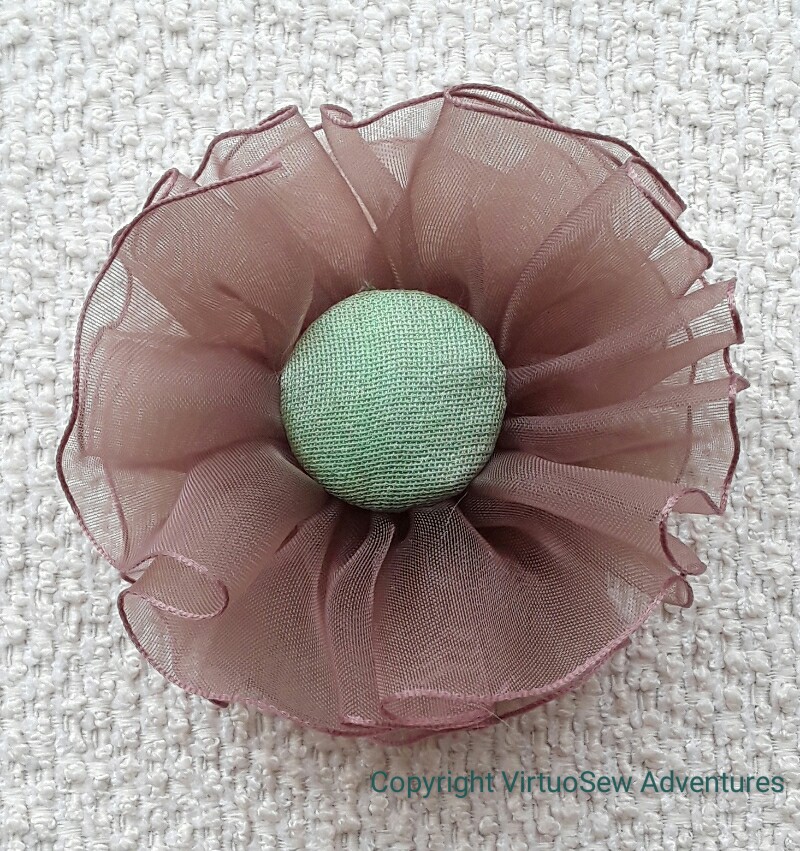
In the end, I covered another self-cover button with two layers of a rather gorgeous silk fabric which I originally bought for my mother to line a bookbox she made for a fine binding of “The Wind In The Willow”, and created a cross between a winner’s rosette and a new species of flower.
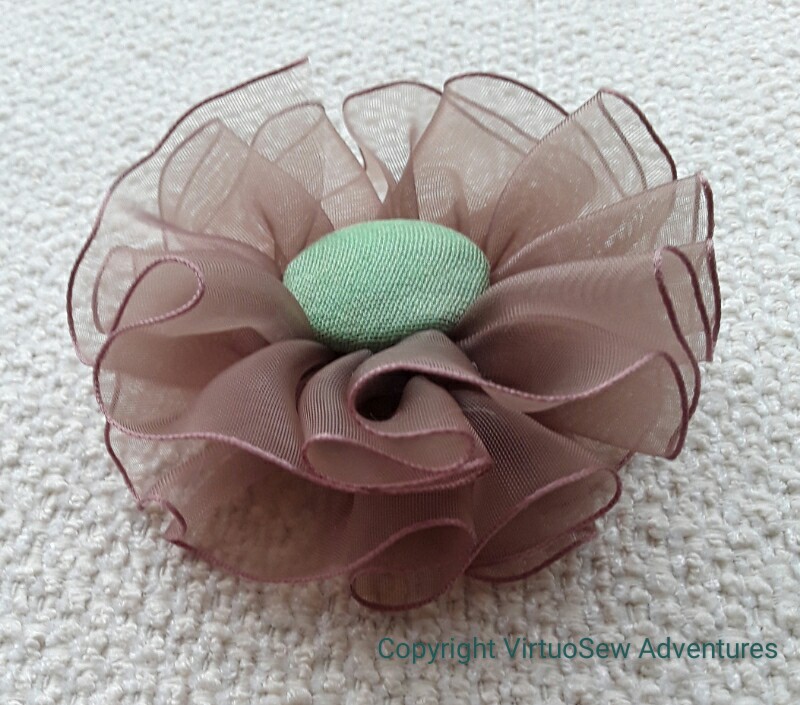
I think it will be fun to wear, but the real delight is the ruffle… It has “loft”, and a gentle glimmer, both from the gauze and from the silk button. More of a spring than an autumn piece, with that light spring green and and the gauzy ruffle, but I’ll look forward to the treat!
Talking of unnatural flowers….
What I would really like to do is think of something else to do with the tweed fabric in the centre of this. It was cut off a pair of trousers which were too long for me, but it is a nice fabric and I want to create something fun with the scraps.
Thinking caps on, then…
Making Brooches
Those who follow me on Instagram may recall that I posted a picture of goodies acquired from L’uccello, on Swanston St in Melbourne, when I was there over the summer. Since I went in with no particular end in view, I was completely bewildered by the range of possibilities I found, so I didn’t buy very much, but now I know where to find them, I will do my homework in advance!
When I came home, vague and somewhat jetlagged, I sat and played with the felt and thread (a cotton from Sajou, a brand I’ve heard of, but never used before) that I’d bought, blanket stitching the felt shapes I had bought, and then attaching the felt ball using a whipped spider’s web stitch, pulled tight to flatten the ball slightly into the stacked shapes, and made a brooch. It works well, and there’s a lovely shine from the cotton.
I enjoyed myself so much (somewhat to my surprise, as small, fiddly projects don’t go well with jetlag!), I started thinking of other brooches I might make. You may have noticed that I love Teal, in almost all shades, so my next effort was to cover different sizes of self-cover buttons with different teal fabrics. In fact the most difficult thing here was to devise a backing that might help to stack the buttons as I wished them to be stacked. In the end, I created a roll of felt, and sewed the buttons to that. The finished brooch looks a lot better than in the photo, which has killed off the colour.
Adventures with a screen print
It occurred to me recently that when I finally finish the Dreams of Amarna panels I will probably want to exhibit them somewhere – displaying them at home would require a complete redesign, including moving walls! – and that, however large or intricate they may be, two panels do not an exhibition make.
At the same time, however, I’d had an idea for a design for which I could apply the combined silk and gold stitches of the Tudor Rose, and furthermore, that might allow me scope, later, to play with some of the mixed media techniques that are available…
So I went rummaging among the assorted copyright-free and Creative Commons images on the web (my goodness, there are thousands!) and found a photo of the famous painted head of Nefertiti which is in the Berlin Museum. Then with some cropping and processing, from a photo of the bust in its case it became a plain headshot with no background, rendered in the style of an old-fashioned newsprint picture. An email conversation and a payment later, that image had been turned into a custom-made Thermofax screen…
At which point, all the simplicity fell over. I’ve actually done four screen prints on the faience-coloured linen, and about three on sandy coloured linen, and none of them was good enough for my purposes. I’m not sure whether the screen is too detailed for the fabric or whether it is simply my technique that is faulty.
So I guess I just need to try harder!
Inspired By Spring Flowers – 3
I decided to create a chequerboard effect for the pincushion. The four panels are stab-stitched together with the raw edges visible. I think that makes for an interesting effect, although it can be over-used.
The first panel has a few French Knots, lots of straight stitches, and some singleton scroll stitches around the base of the stems.
The second is lots of French knots, and palmate leaves made of lazy daisy stitches.
The third is primarily lazy daisy stitch, with the flowers made using blanket stitch.
The four panel is feather stitch with French Knots.
The pincushion is only lightly stuffed. I felt that somehow stuffing it to the point of solidity wouldn’t be quite right, although I don’t know why.
In this case I closed the edges with glove stitch. This is really a sort of variant on overcast stitch, so it isn’t difficult, but – even with shaggy bits of embellished fabric appearing around the edges! – it gives a slightly more “finished” effect.
One of those details that most people don’t consciously notice, but it still has an effect…
The finished set looks cheerful and springlike, in spite of the increasingly distant relationship between the stitchery and the spring flowers that inspired me.
I’m rather pleased; even if it took me months to find the inspiration, the final result makes me smile!
Amarna Geese – stage 2
I’ve started adding more detail with needle and thread. The chevron pattern, the eyes, and the detail on the beak are all made using straight stitches in single strands of Appletons wool. I can’t think where I got a whole series of greys, unless it’s from hand-me-downs. I’m glad I have them now, but it isn’t a colour I much like and I can’t imagine going out and buying them!
For the legs, I have used three different colours of wool in the needle. I can see that for all my staring at photographs and trying to sketch, I’ve not really got a clear or accurate idea of the details of goose anatomy! And somehow, for all my care in placing the cut out felt geese, they’ve ended up attached in not-quite-the-right place.
Still, let’s not despair.
I’ve also added some ground below the the geese. Three strands of different colours of wool, again. I did a sort of loopy knot stitch crossed with a split stitch, which I couldn’t reproduce if I tried. But it produces a very good broken-ground effect, so as long as I don’t decide I need more ground, we’ll be fine.
Then I sat down at the embellisher and tried to blend the fabrics together. This meant quite heavy embellishing, but fortunately the fabrics are none of them dense, so there was room for the fibres to mingle.
When I noticed that the legs weren’t getting caught in, I twisted some more threads around them. That’s better.
Then another pause. Do I add leaves, to match my vague memory, or shall I leave well alone?

